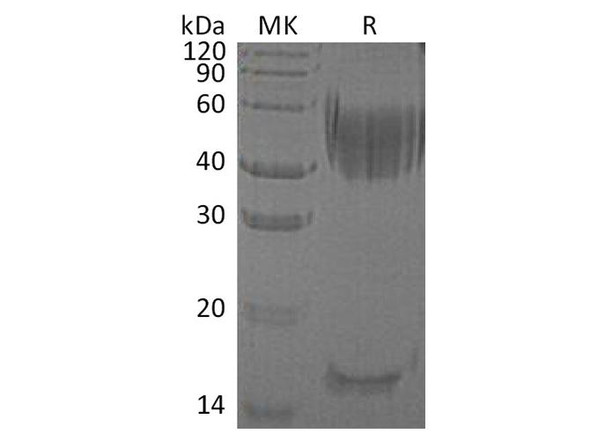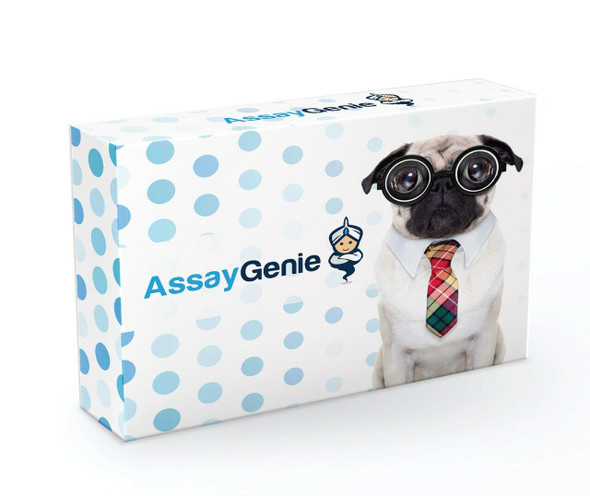Description
| Product Name: | Human Haptoglobin (19-347) Recombinant Protein |
| Product Code: | RPPB3657 |
| Size: | 10µg |
| Species: | Human |
| Target: | Haptoglobin (19-347) |
| Synonyms: | Haptoglobin, Zonulin, Haptoglobin alpha chain, Haptoglobin beta chain, Haptoglobin isoform 2 preproprotein, BP, HP2ALPHA2, HPA1S. |
| Source: | Escherichia Coli |
| Physical Appearance: | Sterile Filtered colorless solution. |
| Formulation: | The Haptoglobin solution (0.5mg/1ml) contains 20mM Tris-HCl buffer (pH 8.0), 10% glycerol and 0.4M Urea. |
| Stability: | Store at 4°C if entire vial will be used within 2-4 weeks. Store, frozen at -20°C for longer periods of time. For long term storage it is recommended to add a carrier protein (0.1% HSA or BSA).Avoid multiple freeze-thaw cycles. |
| Purity: | Greater than 80.0% as determined by SDS-PAGE. |
| Amino Acid Sequence: | MGSSHHHHHH SSGLVPRGSH MGSVDSGNDV TDIADDGCPK PPEIAHGYVE HSVRYQCKNY YKLRTEGDGV YTLNNEKQWI NKAVGDKLPE CEAVCGKPKN PANPVQRILG GHLDAKGSFP WQAKMVSHHN LTTGATLINE QWLLTTAKNL FLNHSENATA KDIAPTLTLY VGKKQLVEIE KVVLHPNYSQ VDIGLIKLKQ KVSVNERVMP ICLPSKDYAE VGRVGYVSGW GRNANFKFTD HLKYVMLPVA DQDQCIRHYE GSTVPEKKTP KSPVGVQPIL NEHTFCAGMS KYQEDTCYGD AGSAFAVHDL EEDTWYATGI LSFDKSCAVA EYGVYVKVTS IQDWVQKTIA EN |
Haptoglogin participates in intestinal permeability, permitting intercellular tight junction disassembly, and controlling the equilibrium among tolerance and immunity to non-self antigens. Haptoglobin has antibacterial activity and takes part in modulating many aspects of the acute phase response. Haptoglobin is processed to yield both alpha and beta chains, which later unite as a tetramer to produce haptoglobin. Haptoglobin binds free hemoglobin (Hb) secreted from erythrocytes In blood plasma with high affinity and thus inhibits its oxidative activity. Further, the haptoglobin-hemoglobin complex is being removed by the reticuloendothelial system.
Haptoglobin Human Recombinant produced in E. coli is a single polypeptide chain containing 352 amino acids (19-347) and having a molecular mass of 39.0 kDa. Haptoglobin is fused to a 23 amino acid His-tag at N-terminus & purified by proprietary chromatographic techniques.
| UniProt Protein Function: | HP: Haptoglobin combines with free plasma hemoglobin, preventing loss of iron through the kidneys and protecting the kidneys from damage by hemoglobin, while making the hemoglobin accessible to degradative enzymes. Defects in HP are the cause of anhaptoglobinemia (AHP). AHP is a condition characterized by the absence of the serum glycoprotein haptoglobin. Serum levels of haptoglobin vary among normal persons: levels are low in the neonatal period and in the elderly, differ by population, and can be influenced by environmental factors, such as infection. Secondary hypohaptoglobinemia can occur as a consequence of hemolysis, during which haptoglobin binds to free hemoglobin. Belongs to the peptidase S1 family. |
| UniProt Protein Details: | Protein type:Secreted, signal peptide; Secreted Chromosomal Location of Human Ortholog: 16q22.2 Cellular Component: extracellular space; extracellular region Molecular Function:antioxidant activity; protein binding; hemoglobin binding; catalytic activity Biological Process: receptor-mediated endocytosis; response to hydrogen peroxide; immune system process; metabolic process; defense response to bacterium; negative regulation of oxidoreductase activity; acute-phase response; defense response Disease: Anhaptoglobinemia |
| NCBI Summary: | This gene encodes a preproprotein, which is processed to yield both alpha and beta chains, which subsequently combine as a tetramer to produce haptoglobin. Haptoglobin functions to bind free plasma hemoglobin, which allows degradative enzymes to gain access to the hemoglobin, while at the same time preventing loss of iron through the kidneys and protecting the kidneys from damage by hemoglobin. Mutations in this gene and/or its regulatory regions cause ahaptoglobinemia or hypohaptoglobinemia. This gene has also been linked to diabetic nephropathy, the incidence of coronary artery disease in type 1 diabetes, Crohn's disease, inflammatory disease behavior, primary sclerosing cholangitis, susceptibility to idiopathic Parkinson's disease, and a reduced incidence of Plasmodium falciparum malaria. The protein encoded also exhibits antimicrobial activity against bacteria. A similar duplicated gene is located next to this gene on chromosome 16. Multiple transcript variants encoding different isoforms have been found for this gene. [provided by RefSeq, Oct 2014] |
| UniProt Code: | P00738 |
| NCBI GenInfo Identifier: | 123508 |
| NCBI Gene ID: | 3240 |
| NCBI Accession: | P00738.1 |
| UniProt Secondary Accession: | P00738,P00737, Q0VAC4, Q0VAC5, Q2PP15, Q3B7J0, Q6LBY9 Q9UC67, B0AZL5, |
| UniProt Related Accession: | P00738 |
| Molecular Weight: | |
| NCBI Full Name: | Haptoglobin |
| NCBI Synonym Full Names: | haptoglobin |
| NCBI Official Symbol: | HP�� |
| NCBI Official Synonym Symbols: | BP; HPA1S; HP2ALPHA2�� |
| NCBI Protein Information: | haptoglobin; zonulin; binding peptide; haptoglobin alpha(1S)-beta; haptoglobin alpha(2FS)-beta; haptoglobin, beta polypeptide; haptoglobin, alpha polypeptide |
| UniProt Protein Name: | Haptoglobin |
| UniProt Synonym Protein Names: | ZonulinCleaved into the following 2 chains:Haptoglobin alpha chain; Haptoglobin beta chain |
| Protein Family: | Haptoglobin |
| UniProt Gene Name: | HP�� |
| UniProt Entry Name: | HPT_HUMAN |










